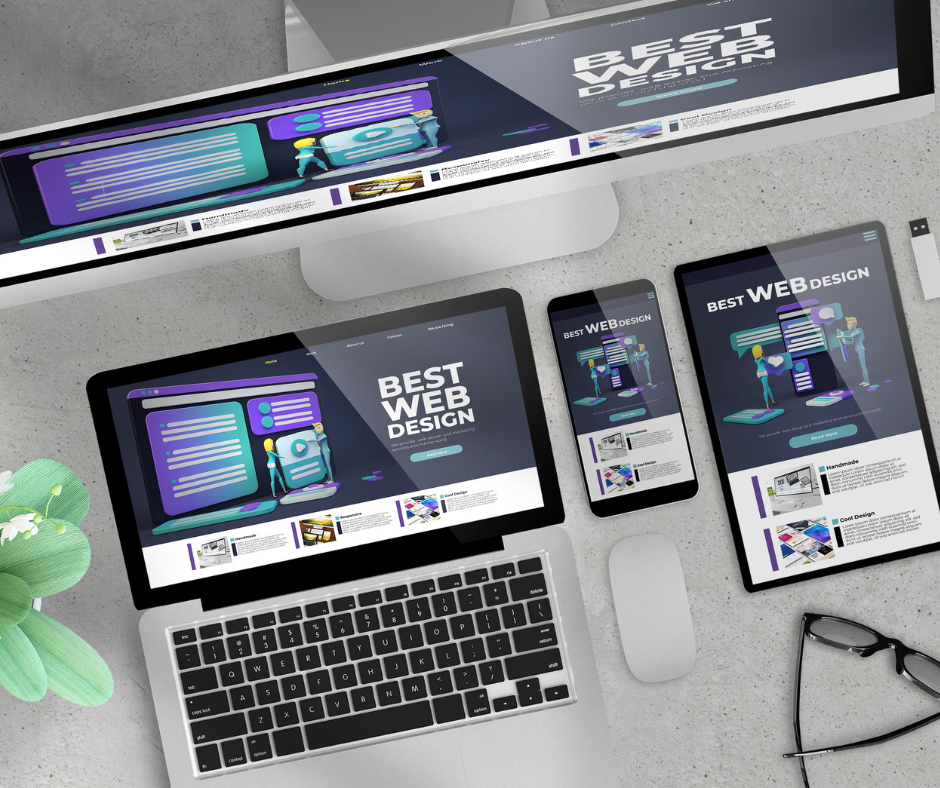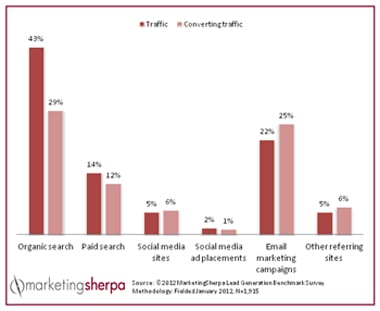Is Your B2B Website Working For You?
If the answer to this question, “Is your B2B website working for you?” is “I’m not sure,” “I don’t know,” or “I think so,” then the real answer is...

Remember when flashing GIFs, scrolling marquees and neon-colored backgrounds were all the rage on websites? While these features may have been trendy in the early 2000s, they now scream outdated and unprofessional.
And here’s the kicker: Your website doesn’t even have to be that old to feel outdated and operate inefficiently. Web design trends and user preferences change rapidly, and a site that was created just a few years ago could already be in need of a website redesign.
However, while When you are busy running your business, keeping up with the ever-changing internet, putting out fires, making hundreds of little decisions every day, the last thing you want to tackle is making more decisions about website themes, color schemes and other elements of a web design process. You likely already know your website needs to do more for your business that just be a nice glossy brochure, but understanding what elements need to in place to make your website work for your business is another story altogether.
In addition to requiring a financial commitment, the website redesign process also involves time and attention, something that many business owners are short on.
Here’s the problem...If you bury your head in the sand and continue to operate with an outdated public image (your company website), you ARE missing out on opportunities, hurting your brand image and wasting your marketing efforts and money. Google alone has more than 3.5 billion searches per day. How many of those Google, Bing or Yahoo searches are looking for you have to offer?
I’ll say it more bluntly...YOU ARE LOSING BUSINESS, AND YOU DON’T EVEN KNOW IT!
The problem is that websites and internet search marketing have evolved over the last several years; it is no longer good enough for you to have the outdated web catalog that most small and mid-sized businesses have out there.
If you haven’t touched your site in a while, here are five signs that say it may be time for a website redesign:
Back in the olden days, say the early to mid-2000’s, we designed sites for the standard 600 x 800 resolution monitors. You know, those heavy monstrosities that sent you to the chiropractor when you lifted them.
We did this to ensure that your site would be viewed without the user having to do much horizontal scrolling.
Then what happened?
Monitors got wider, then even wider, and then they got smaller. Then mobile exploded, then Apple came up with the iPad and then……YOU GET THE PICTURE.
As screen sizes have changed, so has the user experience. If your website requires a lot of scrolling or zooming to be viewed properly, it can be frustrating for users and may cause them to leave your site in search of a more user-friendly experience.
Unfortunately, many of you have websites that are still designed using those old standards. And, quite frankly, it makes you and your brand look ancient. An outdated site also may give potential customers the impression that you aren’t up-to-date on other aspect of your business, either.
The speed at which your website loads is too important to ignore. Internet surfers have the attention span of a 3-year-old in a toy store.
When it comes to website load times, the statistics are clear: The faster your site loads, the better. According to Google, if your website takes more than 3 seconds to load, 53% of users will abandon it.
How does this impact your bottom line? A study by Akamai found that a 1-second delay in page load time can result in a 7% decrease in conversions.
In today’s fast-paced digital landscape, users have come to expect near-instantaneous load times. They don’t have the patience to sit and wait for a website to load, and if your site takes too long, they will quickly move on to your competitors’ sites.
This means that if your website takes too long to load, you could be losing out on a significant amount of business. Even if a prospect is interested in what you have to offer, if your site is slow, they will likely move on to a competitor before they even have a chance to learn more about your brand.
And the sad part is, you will never even know that the prospect came to your website and left.
Slow load times can also impact your search engine rankings. Google has stated that page speed is a factor in its algorithm, meaning that slow-loading sites may not rank as well as faster sites.
All of these factors make load time a critical consideration when it comes to website design. If your site is taking too long to load, it’s a clear sign that it's time for a website redesign project. By optimizing your site’s code and streamlining your content, you can ensure that your site loads quickly and keeps visitors engaged.
The average American has access to more than 10 devices in their household … 10! Phones, tablets, ebook readers and even game consoles are all devices that you can search the internet on in addition to a computer.
And if you’ve been in a restaurant lately, you know how tethered people are nowadays to their electronics. If your website is not mobile-friendly, you are missing out on a significant portion of potential visitors who are using their smartphones or tablets to browse the web.
Mobile-friendly is not only important for user experience but is also among best practices for search engine optimization (SEO). Google, the leading search engine, prioritizes mobile-friendly websites in its search results. This means that if your web pages are not optimized for mobile devices, they may rank lower in search results, resulting in lower traffic and potential revenue.
One of the main reasons why mobile-friendly websites are favored by Google analytics is that they provide a better user experience. When a website is not optimized for mobile devices, it can be difficult to navigate and read on a small screen. This important factor can result in higher bounce rates and lower engagement, which negatively impacts your SEO.
Having a mobile-friendly website is a good idea for any business that wants to stay competitive in today's digital world. If your website is not optimized for mobile devices, it’s time to consider a redesign to ensure that you are not missing out on potential customers and revenue.
If you are lucky enough to keep that visitor on your site for longer than a few seconds, how does your website work for you in terms of trying to convert that visitor into a lead?
As we mentioned above, websites can no longer be just pretty brochures of useless information about how great you are and what great products you have. People just don’t care.
You have to offer the visitor something of value and use call-to-actions, or CTAs. A call-to-action is a prompt or request that encourages the visitor to take a specific action, such as filling out a form, subscribing to a newsletter or making a purchase. A landing page is a standalone page designed to convert visitors into leads or customers by offering something of value in exchange for their contact information. Here is an example of a CTA below.
Without a clear call-to-action or landing pages, visitors may come to your site, browse around for a few seconds, and then leave without taking any action. This means that your website is not working for you in terms of generating leads or conversions.
If you are not using these tools to help you obtain leads, then you need to contemplate a redesign.
However, here’s the most important part of including a CTA and landing page in your website design. To entice visitors to take action on your website, you need to offer them something of value. This could be an e-book, a whitepaper, a free trial, a consultation or anything else that is relevant to your business and provides value to the visitor. Once you have something of value to give, you can use call-to-actions strategically to encourage visitors to take action and download your offer.
A specific landing page is crucial in this process because it provides a clear path for the visitor to follow. The landing page should be designed to provide more information about the offer and to capture the visitor’s contact information in exchange for the offer. This allows you to follow up with the visitor and continue the conversation with them, which can lead to a sale or conversion in the future.
Finally, and perhaps most importantly, your website has to offer value beyond telling people how good you are. Remember those 3.5 billion daily internet searches from above. This is where your site has the opportunity to shine, or it can make you look like an outdated mess.
People are looking for information and they want to do business with a company that offers solutions to their problems.
They also want to avoid a sales confrontation (er! presentation) at all costs. This is where inbound marketing comes in. Inbound marketing focuses on the development of quality content that pulls people toward your company and product. This modern-day approach to marketing attracts targeted traffic to your website by creating relevant content aimed at your buyer personas, or fictionalized representations of your ideal customers.
There are three phases in the inbound marketing methodology:
The Attract phase focuses on “drawing in the right people with valuable content and conversations that establish you as a trusted advisor with whom they want to engage,” according to Hubspot.
Your buyer persona is particularly important in this phase since you need to identify potential customers’ challenges, pain points and goals related to your industry. Once you have this information, you can develop valuable valuabe content (blogs, social media and other content offers) that helps attract your target audience, known as buyer personas, to your website.
The Engage phase focuses on “presenting insights and solutions that align with their pain points and goals, so they are more likely to buy from you,” according to Hubspot.
In the early part of this phase, you’ll develop prospects into qualified leads. Your goal should be to convert and close a prospect by the end of this stage. While you’ll only typically need their email addresses at the beginning, as prospects move down your sales funnel, you’ll likely want to request more information in exchange for something valuable you provide to your prospects (such as an ebook).
Closing tools you may use to engage prospective customers include Customer Relationship Management (CRM) software, email and marketing automation.
The Delight phase focuses on nurturing the customer and developing a long-term relationship. Social media is a great way to delight customers because it provides a platform for them to ask questions and share feedback. Other tools that fall under this phase include surveys, calls-to-action and smart text.
The best marketing strategies will use a flywheel approach, or a less linear approach to lead generation activities. A flywheel design also represents the fact that each action taken by a team member impacts another action.
Improving your internal processes will make your flywheel spin faster, offering the momentum needed to build your business.
People are searching right now for the products and services that YOU have to offer. Can they find you?
If they do find you, what are you doing to turn them into a lead?
If it’s been a while, take the time today to look at your current site and honestly ask yourself these questions:
If the answer to these questions is "No", then it is time to start redesigning your site.
And, if you feel your current website is in need of work, then look at a marketing agency and not just a web design company. You can learn more about why in our article, Web Developer or Marketing Agency - Who Is Better to Create My Website?

If the answer to this question, “Is your B2B website working for you?” is “I’m not sure,” “I don’t know,” or “I think so,” then the real answer is...

For most small businesses, there are limitations when it comes to marketing services because of company finances.

So many businesses focus on getting traffic to their websites that they forget why they are driving traffic there in the first place...to get leads...